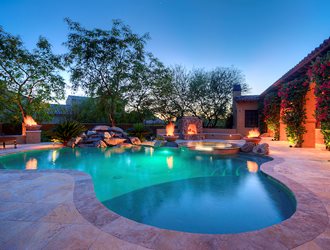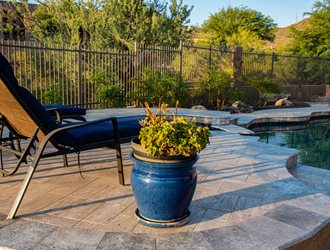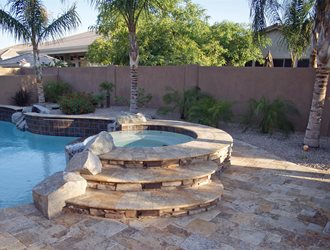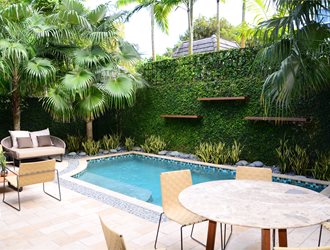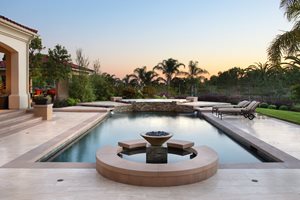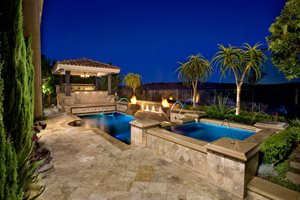TRAVERTINE POOL DECKS & COPING
Learn the pros and cons of using travertine pavers on your pool deck.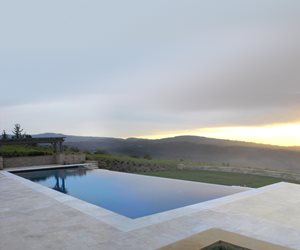
Suzman Design Associates used travertine for the pool deck and pool coping around the infinity edge lap pool in Carmel, CA.
The natural beauty of travertine makes it a popular choice for pool deck coping or as a decking material for the entire pool area. Here, we discuss the pros and cons of using travertine around your swimming pool, the potential costs, and some other options for decking so that you can determine whether it’s the perfect choice for your pool deck.
PROS AND CONS OF TRAVERTINE POOL DECKS
What are the pros of a travertine pool deck?
A travertine pool deck and/or travertine pool coping are great options for the following reasons:
- It offers natural beauty with its earthy colors and interesting textures
- It creates a non-slip surface
- It isn’t hot to the touch, making it comfortable for bare feet
- It’s durable enough to handle typical poolside activities
What are the cons of a travertine pool deck?
The same quality that makes travertine non-slip and comfortable to walk on-its porosity-is the quality that makes it susceptible to staining. Because travertine is porous, it tends to soak up whatever spills on its surface, which can result in staining. Fortunately, there are ways to prevent stains from occurring:
- Seal the surface.
- Wash off spills as soon as they occur.
- Choose travertine that has less of a sponge-like texture, as it’s the holes and crevices that provide spots for things to seep into its pores.
- If you have loose soil nearby that often gets onto the surface, make it a habit to spray dirt off the surface before it begins to stain.
Time / 01:26
Watch this 1.5 minute video to hear why Scott Cohen, Garden Artisan and President of The Green Scene, likes travertine pavers for pool decks.
Is travertine slippery on pool decks?
Travertine tends to have a marbled look, so this is often one of the first questions pool owners ask when they inquire about using travertine around a pool. Contrary to what you might think just by looking at it, travertine is not slippery when wet. Since it’s a naturally occurring material, it has small holes that make it porous-so it actually absorbs water. That means water doesn’t puddle on it either, making travertine essentially a non-slip surface.
Since safety is of upmost importance for pool owners, this quality makes travertine appealing as a material option for pool decking or pool coping.
Is travertine hot to walk on?
Travertine reflects heat and tends to absorb the coolness of the earth below, so it is a comfortable material for bare feet, even on hot summer days. In fact, when people come across travertine for the first time, they are often surprised that it’s often cool to the touch-even if it’s not excessively cool out. Its heat-resistant quality makes travertine a great option for pools that are in areas of the country that see high summer temperatures or pools that don’t get much shade cover during summer months.
Is travertine durable enough for a pool deck?
The short answer: yes, it is very durable. The longer answer: travertine is the material most used in the construction of the Roman Colosseum!
Travertine is natural stone that is formed in hot springs and limestone caves and is essentially a very dense rock. While it’s not prone to getting scratched, cracked, or chipped, it’s important to keep in mind that everything has its breaking point. It’s not impossible for it to get damaged if it experiences high impact. The great thing about travertine pavers is that you can replace them if necessary. When having travertine installed, it’s a good idea to have a few extra pieces on hand in case you need it later.
Some pool owners like the look of naturally aging travertine-it develops a weathered look-but if that look isn’t for you, you can always seal it.
TYPES OF TRAVERTINE FOR POOL DECKS
What colors do travertine pavers come in?
Travertine is commonly used in neutral tones such as cream, beige, brown, and tans. The variety of colors allow for different styles to be achieved.
- A silver travertine pool deck will allow you to incorporate grays into your outdoor space that can be used to create an Old World look.
- An ivory travertine pool deck provides a classic, clean look.
- A white travertine pool deck creates a luxurious marble-like façade.
- Other colors include gold, walnut, noche
What finishes does travertine come in?
Certain travertine finishes are smooth, while others offer more variation. Here are the most popular choices for use outdoors:
- Honed
- Chiseled
- Tumbled
- Brushed
Travertine quality
Travertine ranges in quality, and you’ll find the most variation in color and texture.
- Color. Travertine pavers that have consistent coloration are often more expensive and considered “premium grade.” Color inconsistencies and gray or black markings are usually categorized as “commercial grade.”
- Texture. Travertine that’s smoother and doesn’t have holes that needed to be artificially filled during the manufacturing process are premium grade while material with large holes or gaps that are either still present or needed to be filled are commercial grade.
HOW MUCH DOES A TRAVERTINE POOL DECK COST?
The cost of a travertine pool deck varies depending on several factors such as the size of your pool deck, the condition of your existing surface, and the cost of labor. Generally, the cost of travertine pavers begins around $4-5 per square for materials alone. The costs go up from there and can increase significantly depending on the quality (or “grade”) of travertine you choose. You'll also have to pay for installation.
Is travertine more expensive than pavers?
Travertine pavers are less expensive than some pavers but more expensive than others. Overall, whether you spend more on brick or travertine pavers depends on what quality you want for your materials. For example, a brick paver ranges anywhere from $1.50 to $15 per square foot. So, if you were to choose the highest quality brick, that would be more expensive than a medium-quality of travertine-but less expensive than the highest quality travertine.
Get the look of travertine at a lower cost
With decorative concrete, you can get a look that’s like travertine but at a fraction of the cost. A decorative concrete contractor who does stamping and concrete staining can create the look of travertine with concrete.
PATTERNS FOR TRAVERTINE POOL DECKS
There are many ways to use travertine to create a pattern that fits your style. Here are just a few ideas:
Organize in a grid pattern. For a uniform look, you can have travertine pavers placed in straight line to create a pattern that creates the look of a grid.
Pascale Sucato of Pascale Land Design in Phoenix designed this pool deck with polished travertine laid out in a grid pattern and a darker travertine border framing the swimming pool.
Create a French pattern. A French pattern (also known as Versailles pattern) strays from the typical grid layout in that it uses different sizes of pavers.
This entire pool deck is covered with travertine in a French pattern. The pool coping is also travertine, but the variation in color sets it apart from the rest of the deck to provide contrast.
Combine with other materials. Blending different materials can enrich the look of your pool area. Decorative concrete and stone are just two possible materials that can be paired with travertine to provide variety in texture.
For the veneer of the spa steps, Alexon Design Group in Gilbert, AZ, used stone that coordinates with the variety of color in the travertine to create an eye-catching pool deck.
Stagger pavers. By staggering the lines of your pavers, you can create a look that’s still uniform but less common than a typical layout.
At this backyard retreat in Coral Gables, FL, Lewis Aqüi Landscape + Architectural Design LLC renovated the backyard by resurfacing the pool with Turkish travertine in a staggered design. The border of Mexican river rock adds eye-catching texture.
IS TRAVERTINE A GOOD POOL COPING?
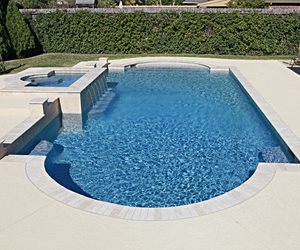
For this backyard pool, the deck’s surface is textured concrete and travertine was used for the coping. VanHart / Shutterstock.
If you want to incorporate travertine but don’t have the budget to install an entirely travertine pool deck, travertine coping is a great option. Travertine pool coping gives you all the great benefits of travertine right along the border of your pool: heat resistance, slip resistance, and durability.
WHAT ARE SOME ALTERNATIVES TO TRAVERTINE?
If travertine isn’t right for your budget or style, here are several other options:
- Decorative concrete (as mentioned above, the right concrete contractor can stamp and stain your decorative concrete to create a look similar to travertine)
- Concrete pavers
- Brick
- Tile
- Wood
- Flagstone
- Granite

 Backyards
Backyards
 Front Yards
Front Yards
